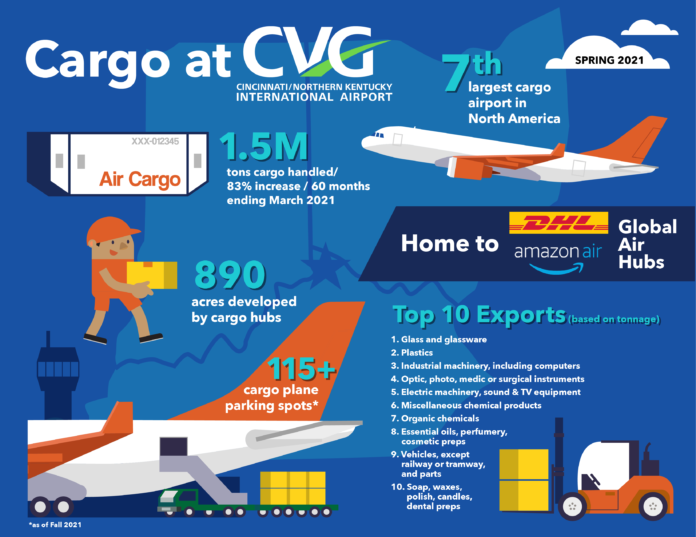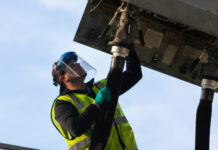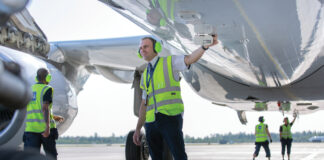

Cincinnati/Northern Kentucky International Airport’s (CVG) is undergoing a cargo make over, putting it on track to become the 6th largest cargo airport in North America.
The airport’s strategic focus to leverage its location and hundreds of acres of available land, create efficiencies for the air cargo supply chain, and support air cargo partners is paying off with more than five years of record-breaking cargo growth (2016, 2017, 2018 2019 and 2020). CVG is also home to global air cargo hubs, DHL and Amazon Air.
In five years CVG will be the epicentre of e-Commerce says Candace McGraw, CEO, Cincinnati/Northern Kentucky International Airport. “We will be a catalyst for even greater economic impact on our local economy with the development of Hangar Row. Through this, we will continue to grow and diversify our air cargo operations and passenger carriers. We plan to leverage aircraft maintenance and support services on and around our airport campus. We will also implement a regional aviation development plan.”
Big stakeholders
The airport’s central US location, its land available for development (the airport property totals 7,700 acres), ample airfield and airspace capacity and four runways, teamed with the agile, business-minded decision making of management, make CVG an attractive location for big stakeholders to take up residence.
Amazon Air’s global cargo hub is currently under development and will open this year. Amazon’s cargo operations have been in full swing since May 2017 and the carrier is a big force in the overall growth of the Airport.
DHL Express has also seen significant growth since it established one of its three global super hubs at CVG in 2013. The company set up home at CVG in 2009 and has made three major expansions investing $380 million and employing 4,600.
Atlas Air and its subsidiaries are major contractors for DHL and Amazon. The company recently established a new 100 sq ft, $34 million operations centre adjacent to CVG’s campus to support existing business and future growth.
Adding to this, an aircraft maintenance hangar developed by Lynxs for FEAM Aero opened in 2020 to service wide-body aircraft.
All of this cargo activity is taking place on the south end of CVG’s campus, McGraw reports, but she notes general cargo activity is seeing an increase as well. A new general use cargo facility was built by Aeroterm in 2019 on the north end of the campus with FedEx as the anchor tenant.
Transformational impact
“CVG’s cargo growth is having a transformational impact on the Cincinnati region. We know there is an immediate economic impact from the expansion projects themselves, $360M by DHL since 2009 and $1.5B in progress from Amazon,” explains McGraw.
“DHL and Amazon alone have hired several thousand additional employees over the last two years. We have also experienced growth on our campus with MRO operations, both construction and employment. Off campus, a number of companies have relocated to our region because of CVG’s cargo growth. Chief of those is Atlas Air who constructed and staffed a $34 million operations centre near the airport.”
“We have instituted several workforce strategies including the launch of a Strategic Workforce Collaborative in 2018, which convenes airport-wide employers to share best practices and work together to provide meaningful career opportunities. A job portal was created to aggregate job openings from around campus into one online site. In partnership with the Kentucky Career Centre we opened a CVG Career Centre in our passenger Terminal for job seeker convenience,” she continues.
“CVG has taken a leadership role in engaging education partners to develop a pipeline of students who are interested in a career in aviation. One programme allows juniors and seniors to take dual-credit classes in logistics management as well as encounter work-based learning experiences. Many of our cargo partners are hiring these students for full-time positions upon graduation of the programme.”
Immense importance
As it has globally, air cargo has been of utmost importance in the US throughout the pandemic.
“Cargo has been immensely important to us in our bottom line throughout the pandemic. It literally helped us keep our lights on. Because we have diversified our operations throughout the last ten years, we have been able to weather the storm,” McGraw says.
“During the early parts of the pandemic, cargo landed weight was around 75% while landed weight from passenger operations were at 25%. Prior to the pandemic in 2019, we saw 55% cargo and 45% passenger. For the balance of 2021, we are forecasting 65% cargo and 35% passenger.”
“The toughest challenge continues to be uncertainty about the depth and duration of the pandemic. After initially losing 95% of passengers and associated revenues in March 2020, through the return of the summer leisure traveler in 2021, to the rise in variants, we have had to be acutely aware of health and safety concerns, while being operationally agile and fiscally prudent.
“Changing consumer behaviours, including touchless ordering in concessions and the rise and impact of e-Commerce, create additional demands and further workforce challenges.
“We have learned it is important to diversify your business model as much as possible.”










